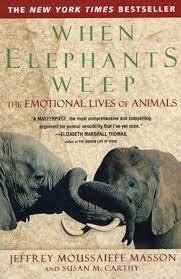When Elephants Weep
 When Elephants Weep: The Emotional Life of Animals
When Elephants Weep: The Emotional Life of Animals
By Jeffrey Moussaieff Mason and Susan McCarthy
Delacorte Press (1994)
Book Review
The main purpose of this book is to address the irrational bias among professional animal researchers that lower animals don’t feel or express complex emotions. This runs contrary to the observations of most caretakers and trainers. Masson compares animals to colonized subjects in this respect. It’s fairly common for Western colonizers to view their subjects as incapable of fully “human” (ie European feelings).*
As Masson points out, all mammal and many vertebrates share the same physiological mechanisms (ie hormones such as oxytocin, epinephrine and testosterone and an amygdala – the a brain structure that triggers fear).** It makes no sense logically that these substances wouldn’t have the same effect in these animals as in human beings.
Masson cites dozens of observations from animal caretakers and trainers.
Shame and embarrassment:
Chimpanzee behavior dramatically affected by presence of mirror or video camera (removed paint from their faces, yawned less if they had broken teeth).Chimpanzees and gray parrot stop aggressive and courting behavior when human observer present.Cats, dogs and elephants hate being laughed at, which can make them aggressive.Altruism
The signing chimp Nim Chimpsky patting sad people and wiping away their tears.A caged chimp rescuing an injured sparrow and handing it to the keeper.Gombe chimps (in the wild) defending one another against attack from wild pig.Four unrelated females gazelles protecting a faun from a hyena.Zebras energetically defending both young and adult zebras from wild dogs.Water buffalo chasing away lions when one of them attacked.Foxes and mongooses observed bringing food to injured adults.Dolphins carrying injured pod members to the service to breathe.Wild chimpanzee observed fetching fruit for his aged mother.Grief
Male gorillas demonstrating sad, slumped posture after death of a mate.Elephants shedding tears of grief.Wild chimps becoming profoundly despondent (and refusing to eat) following death of mate or parent.Beavers shedding tears when restrained.Joy
Horses frolicking when let out to pastureMonkeys and orangutans grinning while being caressed.Rhinoceroses kicking and rearing when released from their pen.Dolphins making joyous vocalizations (soft chuckles) when reuniting with other pod membersFather and daughter observed rolling, diving, and turning somersaults together.Nim Chimpsky often signed “happy” (in American Sign Language) when tickledGoats dancing (rearing, leaping, whirling) when they discover plentiful food.Happy elephants clicking their tusks, twining their trunks, rumbling, trumpeting, rubbing and screaming when reunited with other members of their herd.Play
African elephants playing in the rain, running and bumping each other.Young elephant making numerous attempts to sit on a swing when he saw human children swinging on it.Alaskan buffalo deliberately sliding on ice.Bears and otters sliding on snow banksA wild alligator observed playing with droplets falling into his pond from a pipe.Dolphins playing with seaweed and feathers.Beluga whales carrying stones and seaweed on their heads, which other whales try to knock off.Lions wrestling twigs and pieces of wood away from one another.*Historically it was believed Africans and babies were less susceptible to pain than adult Europeans. Until 1980, babies were believed not to feel pain and underwent surgery without anesthesia.
**Masson neglects to mention lower mammals also possess mirror neurons, a type of sensory-motor cell located in the brain that is activated whether an individual receives a stimulus or merely observes someone else receiving a similar stimulus.
The Most Revolutionary Act
- Stuart Jeanne Bramhall's profile
- 11 followers



